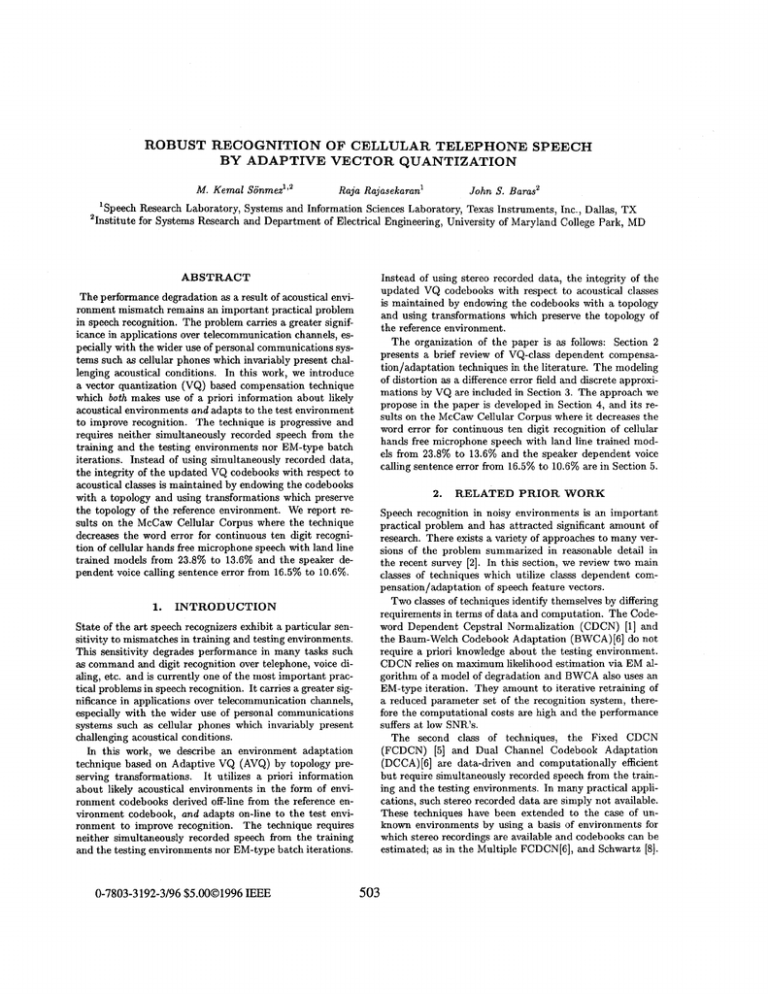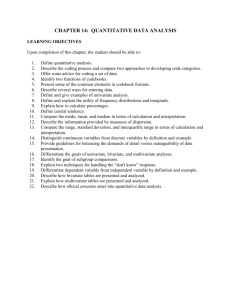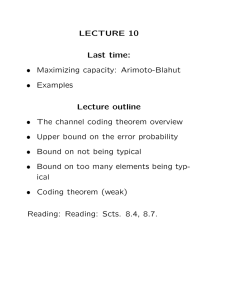ROBUST RECOGNITION OF CELLULAR TELEPHONE BY ADAPTIVE VECTOR QUANTIZATION SPEESCH
advertisement

ROBUST RECOGNITION OF CELLULAR TELEPHONE SPEESCH
BY ADAPTIVE VECTOR QUANTIZATION
M. Kemal Sonmez’?’
John S. Baras2
Raja Rajasekaran’
‘Speech Research Laboratory, Systems and Information Sciences Laboratory, Texas Instruments, Inc., Dallas, TX
’Institute for Systems Research and Department of Electrical Engineering, University of Maryland College Park, MD
ABSTRACT
The performance degradation as a result of acoustical environment mismatch remains an important practical problem
in speech recognition. The problem carries a greater significance in applications over telecommunication channels, especially with the wider use of personal communications systems such as cellular phones which invariably present challenging acoustical conditions. In this work, we introduce
a vector quantization (VQ) based compensation technique
which both makes use of a priori information about likely
acoustical environments and adapts to the test environment
to improve recognition. The technique is progressive and
requires neither simultaneously recorded speech from the
training and the testing environments nor EM-type batch
iterations. Instead of using simultaneously recorded data,
the integrity of the updated VQ codebooks with respect to
acoustical classes is maintained by endowing the codebooks
with a topology and using transformations which preserve
the topology of the reference environment. We report results on the McCaw Cellular Corpus where the technique
decreases the word error for continuous ten digit recognition of cellular hands free microphone speech with land line
trained models from 23.8% to 13.6% and the speaker dependent voice calling sentence error from 16.5% to 10.6%.
1.
INTRODUCTION
State of the art speech recognizers exhibit a particular sensitivity to mismatches in training and testing environments.
This sensitivity degrades performance in many tasks such
as command and digit recognition over telephone, voice dialing, etc. and is currently one of the most important practical problems in speech recognition. It carries a greater significance in applications over telecommunication channels,
especially with the wider use of personal communications
systems such as cellular phones which invariably present
challenging acoustical conditions.
In this work, we describe an environment adaptation
technique based on Adaptive VQ (AVQ) by topology preserving transformations. It utilizes a priori information
about likely acoustical environments in the form of environment codebooks derived off-line from the reference environment codebook, and adapts on-line to the test environment to improve recognition. The technique requires
neither simultaneously recorded speech from the training
and the testing environments nor EM-type batch iterations.
0-7803-3 192-3/96 $5.0001996 IEEE
Instead of using stereo recorded data, the integrity of the
updated VQ codebooks with respect to acoustical classes
is maintained by endowing the codebooks with a topology
and using transformations which preserve the topology of
the reference environment.
The organization of the paper is as follows: Section 2
presents a brief review of VQ-class dependent compensation/adaptation techniques in the literature. The modeling
of distortion as a difference error field and discrete approximations by VQ are included in Section :3. The approach we
propose in the paper is developed in Section 4, and its results on the McCaw Cellular Corpus where it decreases the
word error for continuous ten digit recognition of cellular
hands free microphone speech with land line trained models from 23.8% to 13.6% and the speaker dependent voice
calling sentence error from 16.5% to 10.16%are in Section 5.
2.
RELATED PRIOR ’WORK
Speech recognition in noisy environments is an important
practical problem and has attracted significant amount of
research. There exists a variety of approaches to many versions of the problem summarized in reasonable detail in
the recent survey [2]. In this section, we review two main
classes of techniques which utilize classs dependent compensation/adaptation of speech feature vectors.
Two classes of techniques identify themselves by differing
requirements in terms of data and computation. The Codeword Dependent Cepstral Normalization (CDCN) [l]and
the Baum-Welch Codebook Adaptation (BWCA)[6] do not
require a priori knowledge about the testing environment.
CDCN relies on maximum likelihood estimation via EM algorithm of a model of degradation and BWCA also uses an
EM-type iteration. They amount to iterative retraining of
a reduced parameter set of the recognition system, therefore the computational costs are high and the performance
suffers at low SNR’s.
The second class of techniques, the Fixed CDCN
(FCDCN) [5] and Dual Channel Codebook Adaptation
(DCCA)[6] are data-driven and computationally efficient
but require simultaneously recorded speech from the training and the testing environments. In many practical applications, such stereo recorded data are simply not available.
These techniques have been extended to the case of unknown environments by using a basis of environments for
which stereo recordings are available and codebooks can be
estimated; as in the Multiple FCDCN[B], and Schwartz [8].
503
Voronoi tessellation boundaries
Figure 1. The difference vector field b e t w e e n t w o
acoustical environments ( 0 and *)in a 2D f e a t u r e
space.
This very important constraint has allowed both techniques to be used only with different types of microphones
for which stereo recordings made in a studio environment
are available. It would not be possible to collect simultaneously recorded data for a variety of environments of
practical importance, such as cellular phones in moving vehicles, etc. The technique we present bypasses the need for
simultaneous stereo recordings by adapting the reference
VQ codebook to secondary environments while maintaining the integrity of classes by preserving the topology of
the reference environment.
A second major difference is that the codebooks in the
referenced approaches are fixed throughout recognition, and
once an environment in the available set of environments
is selected, compensation vectors or adaptation codebooks
are not changed. In the technique presented here, the codebook selected among the available environment codebooks
is adapted to the test environment on-line in a robust manner and therefore even if the initial match between the environments is not as good, it gets better as the codebooks
get updated.
3.
D I S T O R T I O N I N THE F E A T U R E S P A C E
In the front-end of the HMM speech recognizer used in this
work, a broad range of features such as frame energy, voicing, spectra and their derivatives are concatenated to form
a high dimensional feature vector. Principal component
analysis is applied to this high dimensional vector space to
reduce dimensionality by selecting a subset of axes along
which statistical variation is maximal. We denote the resulting principal component vector space by F. Vector
quantization is applied to F,therefore, members in a class
are related not only in terms of their spectra as in many
other approaches, but by both static and dynamic features
which determine in a more complete manner the way they
are affected by the environment.
A Gaussian mixture is a common assumption for
Figure 2. VQ codebooks of t w o environments (1
and 2 ) w i t h the topology preserved.
the distribution of the feature vectors of the reference
environment[l, 71. Figure 1 depicts the difference vector
field between two Gaussian mixtures in a 2D feature space.
Even with an acoustical degradation model as simple as
linear filtering and additive Gaussian noise, the distribution of a Gaussian class of log-spectral feature vectors after degradation is no longer Gaussian [7]. Non-parametric
approaches such as VQ may therefore be more reasonable choices for modeling the distribution of feature vectors
in various environments. VQ-class dependent techniques
model the difference vector field as the difference between
the VQ codebooks for the two environments. Let us denote
the codebooks as X h = {x; E F = %', k = 1,.. . ,K } , h =
1,2. Then, a discrete approximation to the difference vector
field is the set of vectors {xi -xi E F = %', k = 1,. . . , K } .
In this work, we are mainly interested in the estimation of
these vectors in the absence of simultaneously recorded (labeled) speech. The problem is to preserve the class pairs
between the two codebooks with unlabeled data.
4.
TOPOLOGICALLY CONSTRAINED
A D A P T I V E VQ
An acoustical environment is described by a VQ codebook,
X h = {x: E F,k = 1,. . . ,K } where each codevector xk
in the feature space 3 represents a class of feature vectors. The VQ codebook for the reference environment,
XYef = {xTf E F , k = 1,..., K } is designed using the
Generalized Lloyd algorithm [4].The design criterion is the
minimization of the distortion
D = E[d(x, x;')]
(1)
where the "winner", w, is given by
w = argminIx-xJef12
j
(2)
In the VQ codebooks for the testing environments, X =
{Xh,
h = 1,.. . ,H } , xLef and x: must correspond to identical acoustical classes. With a simultaneously recorded
504
Progressive compensarion
[
,
Icompjmated
speechfeature
vector
I
codhdu
I
I
I
I
II
I
A priori information about
representative acoustical
environments(off-line)
Figure 3. Off-line topology preserving V Q codebook
adaptation for a set of representative environments.
Fiaure
4. Compensation with both a priori informat ion about likely environments and on-line adaptation.
stereo database, this is automatically satisfied since all the
frames are labeled, and class confusion does not occur. In
most practical cases, however, only unlabeled data are available.
where x(t), t = 0,. .. ,T are the available (unlabeled) data
from the testing environment and the codebooks for the
test environments are initialized with the codebook of the
reference environment
Topology preserving codebook adaptation
To address the codebook integrity problem, we propose a
codebook adaptation technique which preserves the neighborhood relations in the reference codebook by introducing
a modified distortion measure for VQ. The idea of topology
preservation is due to Kohonen [3]. It is one of the mathematical frameworks for the Self Organizing Map (SOM),
a VQ algorithm. The topology of SOM is on a non-linear
projection of the signal space onto a 1D or 2D “map”, and
is arbitrarily decided a priori. In our technique, the topology is directly on the feature space and simply determined
by the distortion measure in the reference environment.
The topology of the reference environment, i.e. the local
neighborhood relations, is captured with the neighborhood
function
4.1.
k = 1,. . . , K.
xk(0) = xFf,
(6)
Notice that in the adaptation, the neighborhood function is
also dynamic in the following form
nij
(
Ix;ef
( t ) = a(t)exp --
’)
- xyf 2
202(t;
v i , j = 1,..., K . (7)
The functions a(t)and a2((t)
are monotonically decreasing.
For initial large values of cr2(t),all codevectors are updated
similarly, thus the algorithm in the beginning may be regarded as an incremental version of simple mean normalization. The scale of adaptation is made finer by decreasing
a2(t)as increasingly more data are used.
Computation of the compensation vectors
The off-line codebook adaptation described in the previous
section is carried out for a set of representative environments as shown in Figure 3. Once the codebooks are available, they are simply used as a basis in which to express the
data from an unknown environment. For a discrete density
HMM, the technique may be regarded as codebook adaptation, for a continuous density HMM, such as the one used in
this work, it is necessary to put it in the form of a compensation algorithm as follows. Let the incoming speech feature
vector(t-th frame of the utterance) from the unknown test
environment be denoted as x(t). Then, the compensated
feature vector, k(t) is computed as
4.2.
Practically, only N-closest neighbors (N=5-10) are kept and
the rest of the n i j ’ s are set to zero leading to the representation of the topology as an elastic mesh as in Figure 2. The
codebook adaptation amounts to stretching of the mesh to
better fit the new environment while keeping the neighborhood relations intact.
Expressed in terms of distortion, the topologically constrained VQ is the minimization of the modified distortion
D’ = E[d(x,x
:
)
]
+ Cn,iE[d(x, x:)]
(4)
ifW
n(t) = x(t) f
where the “winner” w is, similarly, w = argminj Ix(t) xj”( t )( 2
The minimization of D’ is accomplished by the RobbinsMunro stochastic approximation technique, which in the
case of squared error distortion reduces to the incremental
adapt ation
Xk(t
f 1) = xk(t) -k n w k ( t ) [ x ( t )- xk(t)]
ph
h
z P k ( t ) [ x r f - xk(t)]
(8)
k
where the probability that the t-th frame belongs to Voronoi
region k in the codebook h, p k ( t ) , and the probability that
the utterance belongs to environment h, Ph are estimated
as
(9)
(5)
505
,-a
Ph =
E h
the land line and hand held environments which are close to
the VAA. There is a 43% decrease in the error of the hands
free microphone.
A similar experiment was carried out on the speaker dependent portion of the McCaw database. Table 2 summarizes the average results for 30 speakers each uttering 10
names in a voice calling application in which the land-line
is the reference environment. The reference and clean environments are again not disturbed appreciably and there is
a 36% decrease in the error of the hands free microphone.
Cn(Xf:(t)-X(t))2
e-
(10)
.
a Cn(X$(t)-x(t))a
4.3. On-line adaptation
The initial codebook selection is a fast adaptation using a
priori knowledge about likely representative environments.
A new testing environment may not always fit the available
codebooks to give a satisfactory performance. In such cases,
on-line adaptation to the new environment may be accomplished by utilizing the testing environment’s data during
compensation via the same stochastic approximation. This
is shown in the block diagram of the compensation in Figure
4. In this way, even if the initial match between the environments is not as good, it gets better as the codebooks get
updated.
5.
6.
EXPERIMENTAL RESULTS
Results are presented on continuous digit recognition and
voice dialing in the McCaw Cellular Corpus. The corpus
consists of data collected over cellular channels by using
two types of microphones: a hand-held, close talking microphone and a hands-free, visor mounted microphone together with land-line collected speech data. The land-line
and hand-held microphone parts of the corpus are mostly
clean telephone speech comparable in quality to VAA corpus. The hands-free microphone part of the corpus, however, is significantly noisier than the rest.
I
no. of
I
error
I
error
I
CONCLUSION
We introduce a topological constraint to VQ design which
allows adaptation to environments while maintaining the
integrity of the class memberships without using simultaneously recorded speech. This adaptation is used both off-line
to form a basis of representative environments and on-line
to further improve the initial match between the codebook
and the testing environment. The technique is useful in applications where stereo recorded data are not available and
the computational loads must be kept low. It decreases the
word error for continuous ten digit recognition of cellular
hands free microphone speech with land line trained models from 23.8% to 13.6% and the speaker dependent voice
calling sentence error from 16.5% to 10.6% in the McCaw
cellular corpus.
REFERENCES
[l] A. Acero, Acoustical and Environmental Robustness
an Automatic Speech Recognition, Kluwer Academic
Publishers, Boston, MA, 1993.
error
[2] Y. Gong, “Speech recognition in noisy environments:
A survey,”Speech Communication, 16, 1995 pp. 261291.
17.8
13.6
[3] T. Kohonen, Self-organizing Maps, Springer Series in
Information Sciences, Springer-Verlag, Berlin 1995
Table 1. Results of the speaker independent digit
recognition experiment.
1
environment
land line
hand held
hands free
I
no of
utt.’s
696
688
650
1
error
baseline
3.4
4.7
16.5
I
error
w/MN
3.4
4.8
13.4
I
error
w / AVQ
3.7
5.4
10.6
[4] Y. Linde, A. Buzo, R.M. Gray, “An Algorithm for Vector Quantizer Design,” IEEE Trans. Commun., vol.
COM-28, pp. 84-95, January 1980.
I
[5] F.H. Liu, R.H. Stern, A. Acero, P.J. Moreno, “Environment Normalization for Robust Speech Recognition using Direct Cepstral Comparison,” ICASSP-94,
pp. 61-64, April 1994
[6] F.H. Liu, “Environmental Adaptation for Robust
Speech Recognition,” Ph. D. Thesis, ECE Department, CMU, July 1994
Table 2. Results of the speaker dependent voice
calling experiment.
[7] P.J. Moreno, B. Raj, E. Gouvga, R.M. Stern, “Mul-
The first experiment investigates the effectiveness of the
compensation algorithm in normalizing the McCaw speaker
independent digit recognition data to improve recognition
using models trained on the VAAl corpus. The codebook
size for which the results are reported here is 16. The codebooks were trained on data sets in the McCaw and VAA
corpora disjoint from the model training and testing sets
for which the recognition results were obtained. The results in Table 1 indicate that the normalization does not
disturb the reference environment (VAA) appreciably, nor
tivariate Gaussian Based Cepstral Normalization”,
ICASSP-95
[8]R. Schwartz, T. Anastakos, F. Kubala, J. Makhoul,
L. Nguyen, G. Zavaliagkos, “Comparative Experiments on Large Vocabulary Speech Recognition,” Proc. ARPA Human Language Technology
Workshop, Plainsboro, New Jersey, March 1993.
506


